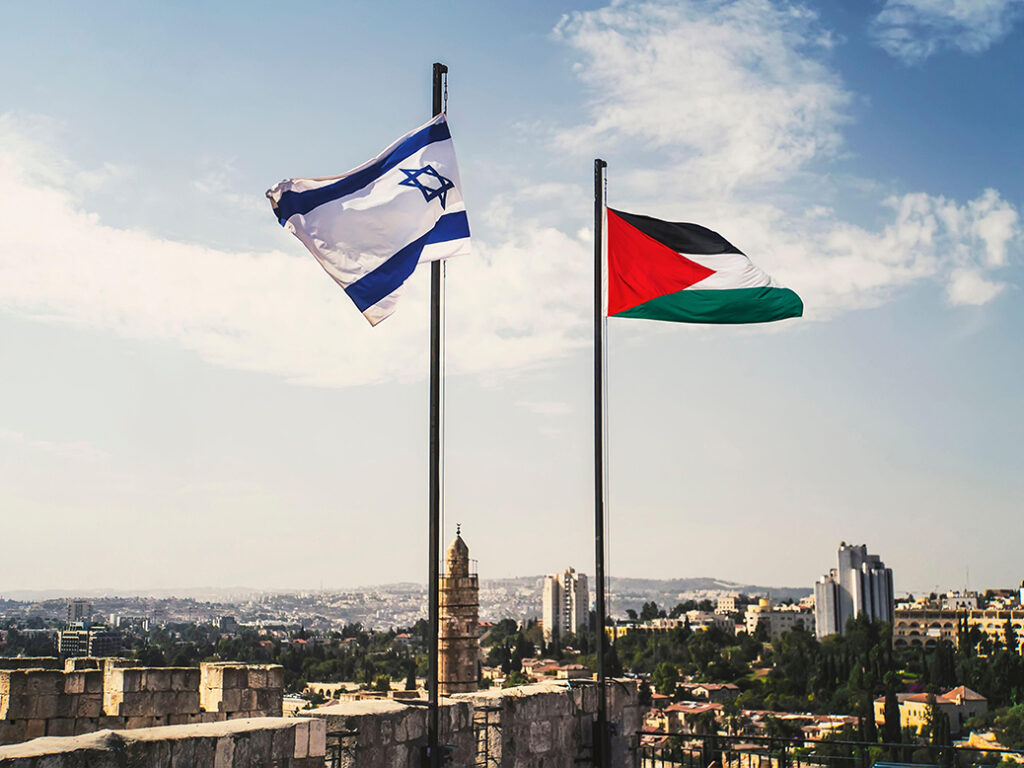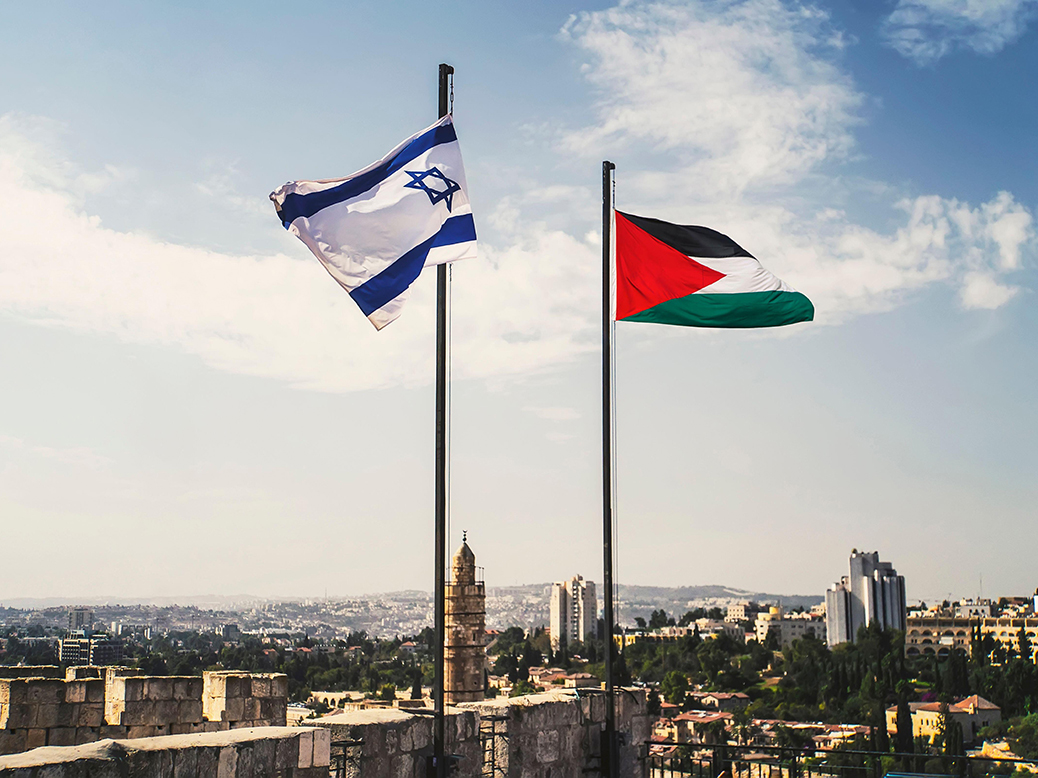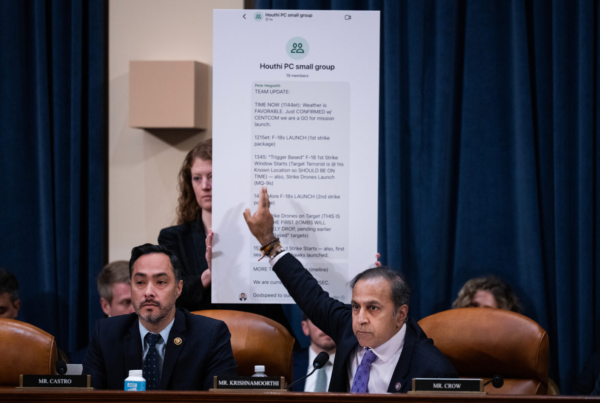This article is part of our collaboration with International Policy Review at IE University. You can read more articles in the series at the link just above.

By Maria Lydia Madieh. Edited by Henri Klein.
Over seven decades of conflict between Israelis and Palestinians have resulted in immense suffering, geopolitical instability, and stalled peace efforts. As the international community grapples with the ongoing humanitarian crisis in Gaza and the West Bank, the question remains: can the Israeli-Palestinian conflict be resolved through a shared state or two separate nations?
The conflict between Palestinians and Israelis regarding territorial disputes has been ongoing since 1948 and is centered around their claims to the Gaza Strip, Jerusalem, and the West Bank. Jerusalem holds profound religious significance: for Jews, it is their holiest city, with the Western Wall and Temple Mount central to their faith; for Muslims, it houses the Al-Aqsa Mosque and Dome of the Rock, Islam’s third holiest site; and for Christians, it marks Jesus Christ’s crucifixion and resurrection. The West Bank is vital to Palestinians as part of their homeland and aspirations for statehood, while Israelis view it as the biblical Judea and Samaria, with holy sites and strategic importance. The Gaza Strip, crucial to Palestinians for trade and resources, raises security concerns for Israelis due to Hamas governance.
After World War I and the collapse of the Ottoman Empire, the Zionist movement made progress toward establishing a Jewish national homeland in Palestine. This was further supported by a statement made by the British Government in 1917 (Balfour Declaration). Consequently, the tension between Jewish and Arab citizens increased. Additionally, due to the events of the Holocaust and World War II, international support for the establishment of a Jewish state increased, which led to the proposal of the 1947 UN partition plan. This plan called for the separation of Jewish and Arab states, with Jerusalem as an international city and capital for both the Palestinians and the Israelis.
While Jewish leaders accepted the plan, Palestinian leaders rejected it. Firstly, Palestinians opposed the plan because it allocated 55% of the land in Palestine to a Jewish state, despite Jews comprising only about 33% of the population at the time. In contrast, Palestinians, who made up 67% of the population, were allocated only 45% of the land. This distribution was considered unfair and disproportionate, given that the indigenous Arab population had lived there for centuries. Secondly, Palestinians saw the plan as a violation of their right to self-determination. They opposed the partitioning of their homeland and the creation of a Jewish state on what they considered Arab land. Thirdly, the decision-making process at the United Nations largely excluded Palestinian voices, leading them to view the UN as favoring Western and Zionist interests, which further increased their mistrust of the partition plan. As a consequence of their rejection, the 1948 Arab-Israeli War (known to Palestinians as the Nakba) broke out, involving Israel and five Arab nations—Jordan, Iraq, Syria, Egypt, and Lebanon.
Additionally, the Nakba whose direct translation in Arabic is ¨catastrophe¨ is used to refer to the mass displacement of Palestinians during the 1948 Arab-Israeli War which resulted in the establishment of the state of Israel and the displacement of a significant number of Palestinians across neighboring countries and the globe. As a result, around 700,000 Palestinians had to leave their homes, the consequences can be seen in Figure 1.
Consequential conflicts transpired, including the Six-Day War and the Yom Kippur War. The Six-Day War began between the Arab states of Jordan, Egypt, Syria, and Israel on June 5th, 1967, due to rising tensions over territorial disputes and mutual distrust. This war resulted in major land gains for Israel. The anger of Palestinians regarding these land gains is justified to many, as the territories were acquired through military force during the Six-Day War, which violates principles of international law, including the prohibition of acquiring land through war (as outlined in the UN Charter). Recognizing this anger is essential to understanding the legitimate grievances of Palestinians and the enduring impact of these actions on the prospects for peace and justice.
In the Yom Kippur War in 1973, Arab states, led by Egypt and Syria, sought to regain territories lost to Israel during the Six-Day War. The war was fueled by Arab nationalism and frustration over Israel’s continued occupation of captured lands. The war ended in a ceasefire, leading to peace negotiations, such as the Camp David Accords in 1978, where Egypt regained the Sinai in exchange for recognizing Israel.
Furthermore, in 1987, the First Intifada which means ¨uprising¨ in Arabic, broke out due to Palestinian anger over the ongoing Israeli occupation of Gaza and the West Bank. The tension was fueled due to occurrences such as lack of political participation, economic hardship, deprivation of essential resources, and settlement expansion. Consequently, the Oslo Peace Accords (an agreement between Israel and the Palestinian Liberation Organization aimed at achieving a peace treaty) was initiated in an attempt to end the ongoing violence. This presented an opportunity for negotiations and the possible key characteristics of the two-state solution. However, many obstacles along the way, such as territorial disputes, the status of Jerusalem, and the Palestinian refugees’ right of return halted all possible peace talks.
The Second Intifada (2000–2005) was triggered by a combination of political, social, and economic grievances. This period of violence between Palestinians and Israelis ended with the Israeli army withdrawing from Gaza. However, withdrawing did not mean Gaza was independent, many things were kept in the hands of the Israelis, such as control of the borders and necessities. This is why Gaza is often referred to as the world’s largest open-air prison, demonstrating the ongoing struggle for co-existence between the two nations.
Solutions
The first possible solution that is often discussed is the one-state solution which calls for the establishment of a single, democratic state and for both the Palestinians and the Israelis to live in co-existence. Various supporters believe that this would deal with all issues of justice and equality. However, this solution faces significant criticism due to concerns over demographic shifts. For example, Palestinians might one day surpass Israelis in numbers within such a state, which could threaten the Jewish identity of Israel. On the other hand, to preserve a Jewish majority, there might be a need for policies that diminish the status of Palestinians, which could compromise the democratic values of the state. These demographic disparities evoke concerns over the potential erosion of national identity for both groups, making the viability of this solution even more complex.
On the other hand, the two-state solution calls for the creation of an independent Palestinian state, agreed-upon borders, and a common capital in Jerusalem coexisting with Israel. Although there is international support for this solution, its implementation has been challenged by several issues, such as disagreements over final borders due to settlement expansion in the West Bank and security concerns such as fear of terrorism and the safety of citizens on both sides.
The one-state solution approach seeks to address the issues of the conflict by promoting principles of equality, human rights, and shared governance. A key principle of this approach is the emphasis on inclusivity, which aims to create a political entity where both parties can coexist as citizens with equal rights and responsibilities. Advocates argue that such a framework would eliminate the existing barriers, which foster an environment that is based on justice and respect for diverse identities. Practically however, this framework has yet to be effective in achieving peace or ensuring equal rights and access to opportunities for Palestinians.
In addition to the unitary solution, there are two other models of the one-state solution that exist. The second model calls for annexing the West Bank, where it would operate as an autonomous region. A third model suggests a Palestinian-Israeli confederation, a de facto two-state solution. Both independent states would share power in certain areas, particularly Jerusalem, and grant residency rights to each other’s citizens. A confederation would formalize shared governance and residency rights, allowing individuals from both states to live in each other’s territories while maintaining separate citizenships. For any solution to progress, many leaders agree that the Palestinian Authority, the Fatah-controlled governing body, must regain control over the Gaza Strip, currently governed by Hamas.
One-state argument
One of the strongest justifications offered by supporters of the one-state solution is the avoidance of territorial fragmentation. This solution would promote a sense of unity and shared national identity, by tearing down physical barriers that currently exist. For this to be successful, all checkpoints between cities must be removed, settlements in the West Bank must open up to all citizens, and law enforcement must be able to communicate with all citizens and, thus, speak Arabic, Hebrew, and English fluently.
One of the key benefits would be shared security and supporters believe that a common state would advance national security for all. Additionally, both groups’ shared dedication to a common nation’s prosperity will act as a basis for their future cooperation and respect for one another, setting a scene for a unified country. One of the biggest challenges, both logistically and ideologically, is the issue of integrating Palestinians displaced since 1948. The number of individuals displaced and the generations that grew up in the past 75 years in the diaspora pose logistical issues such as property rights, identity, and immigration as seen in Figure 2. Beyond the logistical challenges, there are emotional and ideological issues and experiences that must be accounted for. The reconciliation efforts must be sensitive to the historical narratives of both Palestinians and Israelis, recognizing the pain endured by Palestinian refugees and respecting the promises made by their ancestors. Another concern that is posed for this solution which promotes shared governance, is the representation in the political world, which fails to address existing disparities between both sides. Achieving fair and equitable political representation requires striking a balance, a critical yet unaccomplished goal. Addressing historical injustices and power disparities within the framework of a single nation makes this balance not only a political necessity but morally significant.
Two state argument
On the other hand, the two-state solution proposes creating independent nations for Israelis and Palestinians, respecting their distinct identities. By establishing clear borders, this approach aims to provide each community with the autonomy to govern itself, fostering self-determination. This principle has been a cornerstone of past negotiations, such as the Camp David Summit (2000) and the Annapolis Conference (2007), where talks broke down over disagreements on the exact delineation of borders, the status of Jerusalem, and Israeli settlements in the West Bank. The inability to agree on mutually acceptable borders has remained a significant obstacle to achieving a two-state solution.
Within this plan, it is proposed that the Palestinian state would consist of the West Bank, the Gaza Strip, and East Jerusalem as the capital. Israel would retain control over its current territories. A two-state solution holds the promise of granting both Palestinians and Israelis internationally recognized nations where they can exercise their own right of will and self-governance. This acknowledges the importance of autonomy, allowing each community to shape its own political, social, and economic future. A two-state solution would lead to reduced tensions in the region, with defined borders allowing both communities to focus on internal development. This want for security and stability for both parties, emphasizes the desire for peace, creating an environment where individuals can thrive, build their futures, and contribute to their societies without the threat of constant conflict.
The issue of Israeli settlements in the West Bank is deeply intertwined with Palestinian claims to the land, as the settlements further complicate the establishment of a viable Palestinian state. Additionally, historical trends reveal the complexity of convincing settlers to leave, highlighting the deeply rooted struggles for land, identity, and a place to belong. Another significant issue that arises is the claim over Jerusalem. Jerusalem is not just a city; it’s a symbol of identity, religion, and belonging for both Palestinians and Israelis. The conflict over claiming Jerusalem as a capital is a complex issue, reflecting the deep connections people have to their roots and heritage.
Realistic Solution
Although there are efforts, both parties and their populations continue to debate over a solution. As of December 2022, The Palestine/Israel Pulse conducted a joint poll which posed two key questions. The first question presented in Figure 3 was regarding the support for a two-state solution, which found that only 34% of Israeli Jews and 33% of Palestinians favored this option, citing doubts about its feasibility. In response to the second question presented in Figure 4 which showcased the support for a one-state solution, found that only 16% of Israeli Jews and 8% of Palestinians supported this alternative, largely due to historical animosities. The statistics suggest that neither side currently sees a viable path forward, emphasizing the complexity of achieving a resolution to this longstanding conflict with Palestinian resistance often viewed as a means of asserting their dignity and national identity. Thus, finding a possible solution to this conflict in which both parties will accept and maintain the outcome is highly unlikely. Reflecting on historical patterns, world leaders struggle as they are faced with an uncertain future post-October 7th events. Determining the most beneficial solution amid the conflict’s volatility remains complex, although ideally, the most adequate solution in terms of legality is to implement the 1947 UN partition plan. However, since 1947, the relationship between the two states has significantly worsened and increased. Thus, while neither solution is flawless, the Two-State solution presents a more practical and assertive conflict. This is because it acknowledges the distinct identities of both Palestinians and Israelis while providing a basis for mutual recognition and coexistence. For this solution to succeed, several steps must be taken. Firstly, the immediate halt to settlement expansions in the West Bank undermines the territorial integrity of a potential Palestinian state. Secondly, the international community must play a more assertive role in mediating negotiations and ensuring that agreements are upheld. Thirdly, a cease-fire for the ongoing genocide in Gaza must be achieved, as its continuation is fueling current and future generations of Palestinian anger and resilience, which will continue to block any possible peace negotiations between the two states.
Other posts that may interest you:
Discover more from The Sundial Press
Subscribe to get the latest posts sent to your email.





